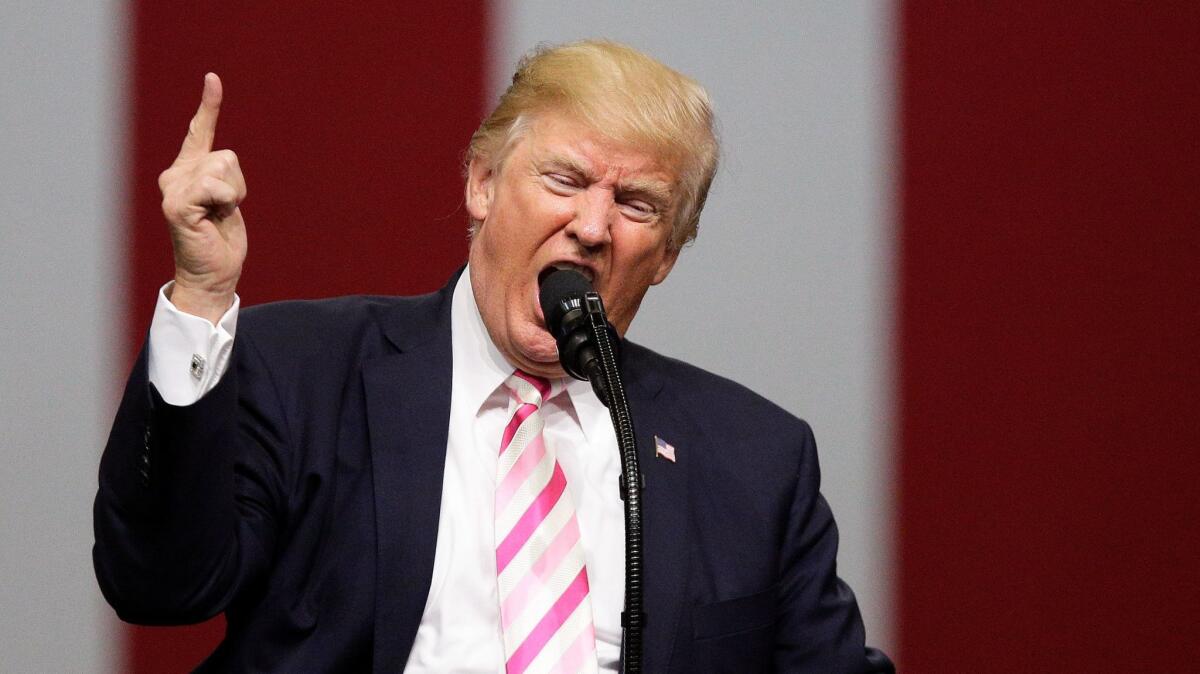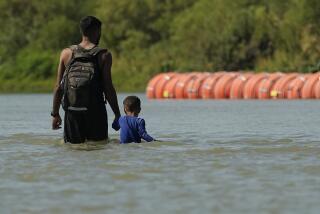Trump plans to slash refugee admissions by more than half

- Share via
Reporting from Washington — President Trump plans to slash the number of refugees allowed in the United States by more than half, pressing a longer-term goal of limiting legal immigration and imposing tougher vetting procedures for foreign visitors.
The Trump administration has told Congress it will limit refugee admissions to about 45,000 in the fiscal year that starts Sunday. That’s down sharply from the 110,000 cap in President Obama’s last year in office, although about 52,000 were admitted because of restrictions put in place after Trump took office.
The new plan would set the lowest cap since the 1980s, after Congress gave the president authority to set a maximum number of immigrants allowed to resettle in the U.S. after being persecuted in their home countries on the basis of race, ethnicity, religion, politics and other specified criteria, according to senior U.S. officials.
The State Department informed the Senate and House judiciary committees of the lower limit Wednesday and, after consultation with Congress, will put the new cap into effect at the end of September, officials said.
Even at that level, only Germany admits more refugees and migrants than the United States. Germany has borne the brunt of the global refugee crisis, granting full refugee status or other protection to more than 1 million Syrians, Afghans, Iraqis, Eritreans and others since 2015.
The caps set a top limit, and the U.S. does not always reach the cap. The last time the U.S. resettled fewer than 45,000 was 2006, when 41,223 were admitted. The lowest level was in 2002, after the Sept. 11, 2001, terrorist attacks, when only 27,131 refugees were admitted.
Some White House officials, including Stephen Miller, Trump’s top policy advisor and an immigration hawk, had sought to set next year’s cap as low as 15,000.
But State Department officials and military leaders pushed back, arguing that resettling refugees from war zones and religious strife protects vulnerable people from danger and lives up to U.S. commitments to allies.
The lower cap comes as administration officials prepare additional vetting procedures that could slow admissions, increasing the backlog and thus further reduce the number of people given refuge.
The new policy seeks to encourage refugees to resettle in their home regions instead of coming to America, according to a U.S. official who briefed reporters on condition of anonymity. To that end, the Trump administration plans to continue to pledge humanitarian assistance overseas, the official said.
The lower limit “is consistent with our foreign policy goals and operational capacity in light of additional security vetting procedures we are implementing as well as domestic asylum backlogs,” the official said.
The administration also ended the Central American Minors refugee program that was designed to help children from El Salvador, Guatemala and Honduras facing persecution at home to be united with family members in the United States.
The Obama administration created the program after a surge of unaccompanied children arrived on the U.S. southern border in 2014 and 2015.
The total refugee limit was set at 85,000 in fiscal 2016, up from 70,000 in the previous three years. The Obama administration raised the cap last year, pledging to resettle 110,000 people, in a push to encourage other countries to do more in the Syrian crisis.
After he took office in January, Trump suspended refugee admissions for 120 days and cut the cap to 50,000. But federal courts allowed authorities to continue admitting refugees who had family in the U.S., and about 52,000 were admitted.
Critics slammed the new cap as insufficient, noting that the United Nations High Commissioner for Refugees estimates about 22.5 million refugees around the world, the largest estimate in U.N. history.
“We are in the world’s biggest refugee crisis in recorded history and this is the lowest number of refugees to be admitted since the passage of the refugee act in 1980,” said Mark Hetfield, the head of HIAS, a Jewish organization based in Silver Spring, Md., that advocates for increased refugee levels.
“It is a total abdication of American leadership,” Hetfield said.
Advocates are concerned that new vetting procedures will slow the refugee admissions process and the U.S. won’t meet the lower cap in the next year.
“The refugee process is already the most stringent processing of any travelers coming to the U.S.,” Betsy Fisher, policy director for the International Refugee Assistance Project, a New York-based organization, said in a phone interview.
“We are expecting to see a longer process with additional layers of security checks,” Fisher said.
Twitter: @ByBrianBennett
More to Read
Get the L.A. Times Politics newsletter
Deeply reported insights into legislation, politics and policy from Sacramento, Washington and beyond. In your inbox three times per week.
You may occasionally receive promotional content from the Los Angeles Times.











